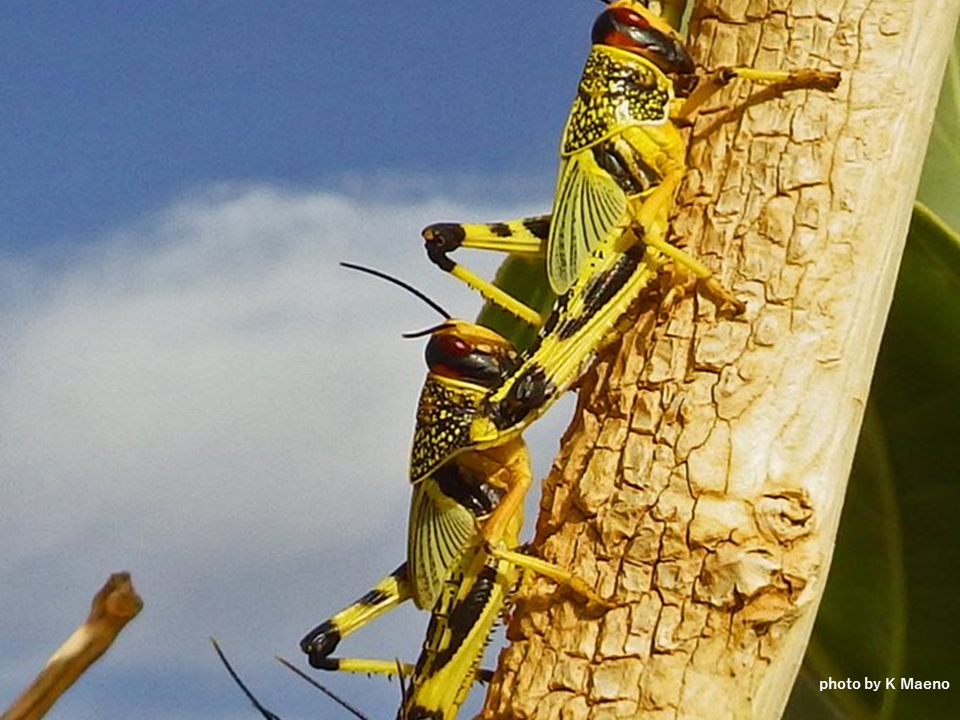Pick Up
845. Understanding Desert Locust Behavior to Avoid Cannibalism During Molting ーAdvancing Eco-Friendly Pest Control Strategies

845. Understanding Desert Locust Behavior to Avoid Cannibalism During Molting ーAdvancing Eco-Friendly Pest Control Strategies
Desert locusts, found in semi-arid regions from West Africa to India, have long been notorious for their devastating impact on agriculture. Outbreaks of desert locusts occur over large areas, and adults in particular fly long distances, posing a formidable challenge to traditional pesticide-based control measures. To address this problem, JIRCAS has been conducting field research to develop more efficient and environmentally friendly pest control technologies based on desert locust ecology. In previous Pick Up articles, we have discussed the importance and direction of preventive control technology development for desert locusts, as well as climate change and locust outbreaks in East Africa, and COVID-19 and scenario analysis of the impact of desert locusts on the global food market. This time, we present the results of JIRCAS research on the collective behavior of desert locust nymphs (larvae), which is essential for the development of pest control methods that lead to a reduction in pesticide use.
One of the central aspects of desert locust behavior is the tendency of gregarious phase nymphs to move in groups. This behavior, initially interpreted as a strategy to avoid potential predators from behind while pursuing individuals in front, has sparked considerable interest in the role of cannibalism. In a remarkable development, a study published in Science in May 2023 (Chang et al., 2023) shed light on how gregarious phase nymphs avoid cannibalism by emitting pheromones in the migratory locusts. Desert locust nymphs have powerful hind legs that allow them to escape from danger quickly. However, during the molting period, they are immobilized and vulnerable to predators, increasing the risk of cannibalism. Understanding how these nymphs avert cannibalistic behavior during this critical period was a central focus of our research.
Through a collaborative field study in the Sahara Desert with the Mauritanian National Desert Locust Center (CNLA) and the French Agricultural Research Center for International Development (CIRAD), we made important discoveries. Nymphs in the gregarious phase, with a high appetite, continued to migrate during the day. However, those on the near molting stopped migrating and feeding, opting to remain on the plant. This behavior suggests that they molted under conditions that minimized the risk of cannibalism. In addition, nymphs congregated on larger plants at night, but those ready to molt move away from non-molting individuals helping to avoid the threat of cannibalism. Our examination of the relationship between molting time and hunger revealed an interesting pattern. Nymphs tended not to molt in the early morning when they were most hungry; instead, many chose to molt during the day when they were satiated from feeding. This physiological adaptation suggested that desert locust nymphs instinctively avoided cannibalism during molting because the risk was greater when they were hungry.
These findings have practical implications for pest management. Desert locusts pause their migration and remain on plants before and after molting, making these periods ideal for targeted control efforts. By taking advantage of this behavior, we can promote environmentally and health-conscious pest management practices that minimize the use of chemical pesticides.
In 2022, the Ministry of Agriculture, Forestry, and Fisheries (MAFF) formulated the Sustainable Food Systems Strategy "MIDORI", which aims to achieve both increased productivity and sustainability in the food, agriculture, forestry, and fishery industries through innovation. This strategy calls for efforts to reduce environmental impact by reducing the use of chemical pesticides and our research has produced results that contribute to the reduction of chemical pesticides used for desert locust control. These results are expected to contribute to the international development of the “Strategy MIDORI”. JIRCAS remains committed to advancing environmentally friendly control methods for transboundary pests such as desert locusts, which continue to pose significant challenges on a global scale.
For more information on desert locusts and answers to frequently asked questions, please visit the JIRCAS website.
References
Chang, H. et al., A chemical defense deters cannibalism in migratory locusts. Science 380,537-543(2023). DOI:10.1126/science.ade6155
Maeno, K.O., Piou, C., Whitman, D.W., Ould Ely, S., Ould Mohamed. S., Jaavar, M.E.H., & Ould Babah Ebbe, M.A. (2023) How locusts avoid cannibalism. Behavioral Ecology, https://doi.org/10.1093/beheco/arad025
2. Towards the development of preventive control technologies for desert locust https://www.jircas.go.jp/en/program/program_d/blog/20200308_0
217. Scenario Analysis of the Impact of COVID-19 and Desert Locust on the Global Food Market
https://www.jircas.go.jp/en/program/program_d/blog/20210122
About Desert Locust
https://www.jircas.go.jp/ja/program/program_b/desert-locust
Contributors: MAENO Koutaro, KOBORI Yoichi (Crop, Livestock and Environment Division), NAKASHIMA Kazuo (Food Program)
